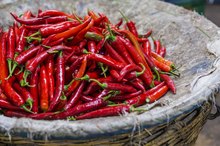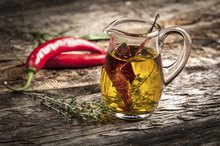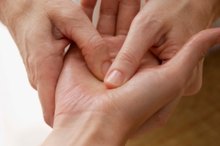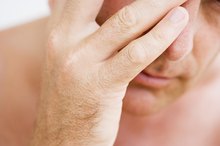What does fact checked mean?
At Healthfully, we strive to deliver objective content that is accurate and up-to-date. Our team periodically reviews articles in order to ensure content quality. The sources cited below consist of evidence from peer-reviewed journals, prominent medical organizations, academic associations, and government data.
- PubMed Health: Arthritis
- PubMed Health: Arthritis
- “Journal of the Medical Association of Thailand”; Efficacy of Symptomatic Control of Knee Osteoarthritis With 0.0125 Percent of Capsaicin Versus Placebo; W. Kosuwon, et al.; October 2010
- “Journal of the Medical Association of Thailand”; Efficacy of Symptomatic Control of Knee Osteoarthritis With 0.0125 Percent of Capsaicin Versus Placebo; W. Kosuwon, et al.; October 2010
The information contained on this site is for informational purposes only, and should not be used as a substitute for the advice of a professional health care provider. Please check with the appropriate physician regarding health questions and concerns. Although we strive to deliver accurate and up-to-date information, no guarantee to that effect is made.
The Effect of Cayenne Pepper on Arthritis
Arthritis is the term for over 100 different conditions, of which the two most common are osteoarthritis and rheumatoid arthritis, according to the Arthritis Foundation. The main symptoms associated with arthritis include pain, inflammation and swelling, stiffness, and loss of joint function. Natural remedies such as cayenne pepper can help relieve some arthritis symptoms. However, consult your doctor for more advice on using cayenne pepper medicinally.
If you are experiencing serious medical symptoms, seek emergency treatment immediately.
Definition
Cayenne is a shrub native to Central and South America, but it’s now cultivated in other subtropical and tropical regions. It can have a red, orange or yellow color when ripe and is known for its hot and spicy taste. Cayenne has been used for food and medicinally for at least 9,000 years, according to the University of Maryland Medical Center. The main active ingredient in cayenne pepper is capsaicin, but it also contains antioxidants such as vitamins A and C and flavonoids.
- Cayenne is a shrub native to Central and South America, but it’s now cultivated in other subtropical and tropical regions.
Effect of Capsaicin on Arthritis
Capsaicin for Neuropathy
Learn More
Pain characterizes all forms of arthritis, including osteoarthritis, rheumatoid arthritis and gout. Capsaicin in cayenne has potent pain-relieving effects. When applied topically in cream or ointment form, capsaicin initially causes a brief stinging sensation, which stimulates the pain nerves. It then gradually reduces substance P, a chemical necessary for nerves to send pain signals.
- Pain characterizes all forms of arthritis, including osteoarthritis, rheumatoid arthritis and gout.
- It then gradually reduces substance P, a chemical necessary for nerves to send pain signals.
Evidence
In a study published in the “Journal of the Medical Association of Thailand” in October 2010, researchers from Khon Kaen University found that 0.0125 percent capsaicin gel was effective in treating mild-to-moderate pain in female patients who had an average age of 61 and knee osteoarthritis 1. Compared to the placebo, capsaicin also improved stiffness and joint function. Although 67 percent of the patients experienced a burning sensation from the capsaicin, none of them withdrew.
Dosage and Side Effects of Capsaicin
The Benefits of Habanero Pepper & Cayenne
Learn More
According to the University of Maryland Medical Center, creams or ointments containing 0.025 to 0.075 percent capsaicin can be applied topically up to four times daily. The burning sensation the study participants experienced is a common side effect of capsaicin. It may also cause itching and increase your pain initially. Also, because you’re applying capsaicin topically, it has no drug interactions and no serious toxicity, according to the Physicians Committee for Responsible Medicine. Allow three to seven days for capsaicin from cayenne to relieve pain and other symptoms relating to arthritis.
- According to the University of Maryland Medical Center, creams or ointments containing 0.025 to 0.075 percent capsaicin can be applied topically up to four times daily.
Related Articles
References
- “Journal of the Medical Association of Thailand”; Efficacy of Symptomatic Control of Knee Osteoarthritis With 0.0125 Percent of Capsaicin Versus Placebo; W. Kosuwon, et al.; October 2010
- Sharma SK, Vij AS, Sharma M. Mechanisms and clinical uses of capsaicin. Eur J Pharmacol. 2013;720(1-3):55-62. doi:10.1016/j.ejphar.2013.10.053
- U.S. Food and Drug Administration. Draft Guidance on Capsaicin. Silver Spring, Maryland; issued October 2018.
- Gagnier JJ, Van tulder M, Berman B, Bombardier C. Herbal medicine for low back pain. Cochrane Database Syst Rev. 2006;(2):CD004504. doi:10.1002/14651858.CD004504.pub3
- Laslett LL, Jones G. Capsaicin for osteoarthritis pain. Prog Drug Res. 2014;68:277-91.
- Babbar S, Marier JF, Mouksassi MS, et al. Pharmacokinetic analysis of capsaicin after topical administration of a high-concentration capsaicin patch to patients with peripheral neuropathic pain. Ther Drug Monit. 2009;31(4):502-10. doi:10.1097/FTD.0b013e3181a8b200
- U.S. Food and Drug Administration. Qutenza (capsaicin) NDA #022395. Drug Approval Package.
- Mccarty MF, Dinicolantonio JJ, O'keefe JH. Capsaicin may have important potential for promoting vascular and metabolic health. Open Heart. 2015;2(1):e000262. doi:10.1136/openhrt-2015-000262
- Jones VM, Moore KA, Peterson DM. Capsaicin 8% topical patch (Qutenza)--a review of the evidence. J Pain Palliat Care Pharmacother. 2011;25(1):32-41. doi:10.3109/15360288.2010.547561
- Qutenza. Patient's Guide.
- Anand, P. and Bley, K. Topical capsaicin for pain management: therapeutic potential and mechanisms of action of the new high-concentration capsaicin 8% patch. Br J Anaesth. 2011 Oct;107(4);490-502. DOI: 10.1093/bja/aer260.
- Babbar, S.; Marier, J.; Mouksassi, M. et al. Pharmacokinetic analysis of capsaicin after topical administration of a high-concentration capsaicin patch to patients with peripheral neuropathic pain. Ther Drug Monit. 2009 Aug;31(4):502-10. DOI: 10.1097/FTD.0b013e3181a8b200.
- Gagnier, J.; van Tulder, M.; Berman, B. et al. Herbal medicine for low back pain. Cochrane Data Syst Rev. 2006 Apr 19;(2): CD004504. DOI: 10.1002/14651858.CD004504.pub3.
- U.S. Food and Drug Administration. Draft Guidance on Capsaicin. Silver Spring, Maryland; issued October 2018.
Resources
Writer Bio
Kay Uzoma has been writing professionally since 1999. Her work has appeared in "Reader’s Digest," "Balance," pharmaceutical and natural health newsletters and on websites such as QualityHealth.com. She is a former editor for a national Canadian magazine and holds a Bachelor of Arts in political science from York University.









